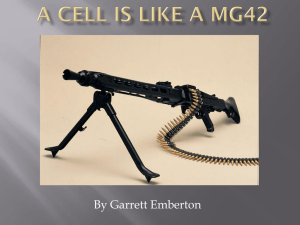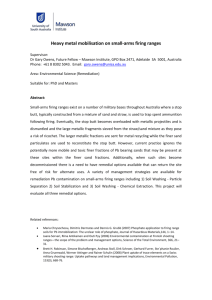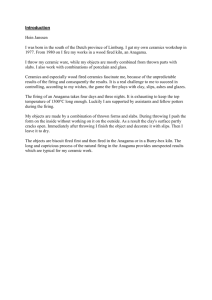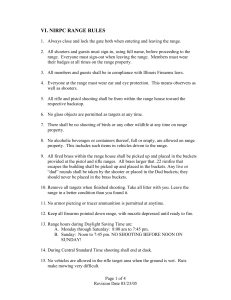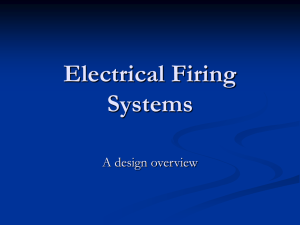orders for the use of the rifle ranges
advertisement
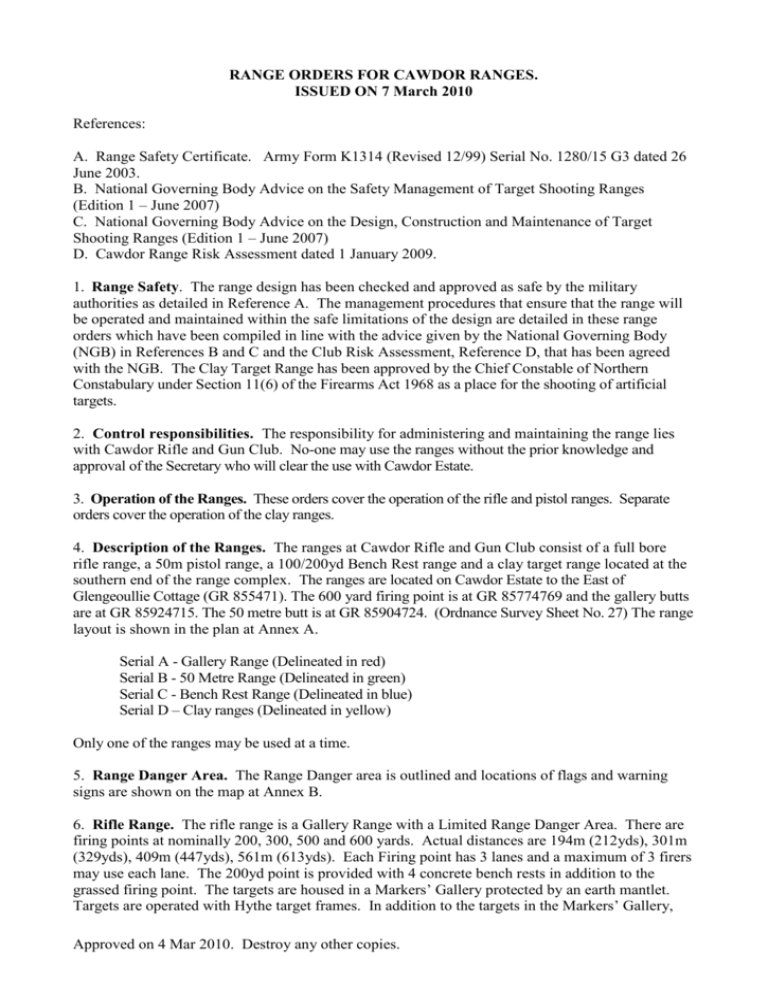
RANGE ORDERS FOR CAWDOR RANGES. ISSUED ON 7 March 2010 References: A. Range Safety Certificate. Army Form K1314 (Revised 12/99) Serial No. 1280/15 G3 dated 26 June 2003. B. National Governing Body Advice on the Safety Management of Target Shooting Ranges (Edition 1 – June 2007) C. National Governing Body Advice on the Design, Construction and Maintenance of Target Shooting Ranges (Edition 1 – June 2007) D. Cawdor Range Risk Assessment dated 1 January 2009. 1. Range Safety. The range design has been checked and approved as safe by the military authorities as detailed in Reference A. The management procedures that ensure that the range will be operated and maintained within the safe limitations of the design are detailed in these range orders which have been compiled in line with the advice given by the National Governing Body (NGB) in References B and C and the Club Risk Assessment, Reference D, that has been agreed with the NGB. The Clay Target Range has been approved by the Chief Constable of Northern Constabulary under Section 11(6) of the Firearms Act 1968 as a place for the shooting of artificial targets. 2. Control responsibilities. The responsibility for administering and maintaining the range lies with Cawdor Rifle and Gun Club. No-one may use the ranges without the prior knowledge and approval of the Secretary who will clear the use with Cawdor Estate. 3. Operation of the Ranges. These orders cover the operation of the rifle and pistol ranges. Separate orders cover the operation of the clay ranges. 4. Description of the Ranges. The ranges at Cawdor Rifle and Gun Club consist of a full bore rifle range, a 50m pistol range, a 100/200yd Bench Rest range and a clay target range located at the southern end of the range complex. The ranges are located on Cawdor Estate to the East of Glengeoullie Cottage (GR 855471). The 600 yard firing point is at GR 85774769 and the gallery butts are at GR 85924715. The 50 metre butt is at GR 85904724. (Ordnance Survey Sheet No. 27) The range layout is shown in the plan at Annex A. Serial A - Gallery Range (Delineated in red) Serial B - 50 Metre Range (Delineated in green) Serial C - Bench Rest Range (Delineated in blue) Serial D – Clay ranges (Delineated in yellow) Only one of the ranges may be used at a time. 5. Range Danger Area. The Range Danger area is outlined and locations of flags and warning signs are shown on the map at Annex B. 6. Rifle Range. The rifle range is a Gallery Range with a Limited Range Danger Area. There are firing points at nominally 200, 300, 500 and 600 yards. Actual distances are 194m (212yds), 301m (329yds), 409m (447yds), 561m (613yds). Each Firing point has 3 lanes and a maximum of 3 firers may use each lane. The 200yd point is provided with 4 concrete bench rests in addition to the grassed firing point. The targets are housed in a Markers’ Gallery protected by an earth mantlet. Targets are operated with Hythe target frames. In addition to the targets in the Markers’ Gallery, Approved on 4 Mar 2010. Destroy any other copies. targets may be placed in the target holders on the 50m range and fired upon from the 200yd point. This gives a shooting range of 100m. Procedures for the operation of the rifle ranges are at Annex C. 7. Bench Rest Range. The Bench Rest range is completely contained within the perimeter of the Gallery Range and shares the same axis. It has four benches situated immediately in front of the Gallery Range 200 yard firing point. Orders for the use of the bench rest range are at Annex C. 8. Pistol Range. The 50 metre range is completely contained within the perimeter of the Gallery Range and shares the same axis. It has eight lanes. Firing is permitted back to 50 Metres. Orders for the use of the 50m range are at Annex C. 9. Firearm and Ammunition Limits. The Range licence specifies the following limits to firearms and ammunition. Max. Muzzle Velocity – 1000 m/s (3275 ft/sec) Max. Muzzle Energy – 7000 Joules (5163 ft/lbs). With effect from 1 April 2008 all MoD ranges were limited to 4500J (3319 ft/lbs). For those firearms with a muzzle energy over 4500J and up to 7000J firers are required to comply with the procedures detailed in Annex D. Max calibre – 0.577” except for muzzle loading and centrefire black powder firearms which are unrestricted in calibre but must not exceed the muzzle energy and muzzle velocity limits. 10. Ammunition Types. The above specification refers to ball ammunition. The use of the following types of ammunition is prohibited:- armour piercing, armour piercing incendiary, tracer, or any military ammunition containing igniferous substances and depleted uranium. 11. Shooting Positions. Prone, sitting and standing positions are authorised by the Range Safety Certificate. If positions other than prone are to be used both the Drum of Clunas and Carn Maol flags must be raised prior to shooting. On normal club meetings where firing will be from a prone position at all times only the Mains of Clunas flag needs to be raised. The Club will then operate under the conditions in Reference D, the risk assessment which the committee have adopted with the advice of the NRA. Only one firing point may be used at any time. 12. Targets. The use of any hard targets such as falling plates is forbidden. To conduct similar practices, balloons or stationary clay pigeon targets may be used. The appropriate targets for the firing point in use are to be used in the Hythe frames or, if using the pistol stop butt, target frames must be mounted in the brackets on the stop butt. Targets must be engaged from the firing point in the same lane. Cross shooting is not permitted. 13. Misses. The risk assessment for operating the range assumes that all rounds fired will be captured by the stop butt. Any firer who cannot hit the stop butt will be required to cease firing and will not be allowed to continue until or unless the zero of the weapon used has been checked and adjusted at short range. The zeroing procedure to be used on the 50m range is detailed at Annex C. 14. Open/closed periods. Firing is permitted only between the hours of 10.00 and 1 hour before sunset. Firing will not take place on Armistice Day or Remembrance Sunday. Approved on 4 Mar 2010. Destroy any other copies. 15. Medical arrangements. A First aid Box will be available at the firing Point and the Butts at all times. The nearest telephone is located at Glengoullie cottage (see map at Annex C) Tel 01667 404501 and the nearest Public phone is in the village of Cawdor. The nearest Accident and Emergency Department is at Raigmore Hospital, Inverness Tel 01463 704000. Should an ambulance be required dial the usual emergency number 999. Mobile phone coverage is not good but should be tried as a first resort. 16. Use of Roads and Parking. Vehicles and pedestrians must use the roadway to access the ranges and Butts. Speeds should be restricted to 10 mph. Authorised parking areas must always be used and these are clearly marked. 17. Other Safety Issues. All persons in close proximity to the firing point must wear effective hearing protection. It is highly advisable to wear hearing protection in the butts. Eye protection should be used when engaged in muzzle loading shooting. 18. Communications. Communications between the RCO and the Butts will be by two way radios provided by the Club. Shooting on the rifle range with a butt party may not take place unless communications between the Butts and the RCO have been established. 19. Security. Members are responsible for the security of their firearms and ammunition at all times. The clubhouses, markers’ gallery and main gate are all secured by padlocks. Members must ensure that the range is properly secured after use. 20. Livestock. Any livestock must be removed from the range danger area before firing can commence. Annexes A. B. C. D. E. Range layout plan. Range Danger area map. Orders for the Use of the Rifle Ranges. High Muzzle Energy Procedures. Accident and Incident Reporting Procedure. Approved on 4 Mar 2010. Destroy any other copies. ANNEX C TO CAWDOR RANGE ORDERS DATED 4 Mar 2010 ORDERS FOR THE USE OF THE RIFLE RANGES RANGE SETUP AND GENERAL ADMINISTRATIVE PROCEDURES 1. Range Setup Procedure. Several actions need to be taken to prepare the rifle ranges for use. A procedure has been developed that shares the workload and ensures that the location of members is known at all times. Flags must be flown at all times the range is in use and only removed when the range is closed. The flagpoles on the range boundary are located at points marked on the map at Annex B. The flags are each marked with the location of their flagpole and are held in the rifle clubhouse when not in use. 2. First Member. The first Full Member to arrive at the range is responsible for organising the setup of the range. He should: a. Proceed to the rifle clubhouse and sign on in the Range Log. b. Post the Main Gate flag and then remain in or around the Clubhouse until the second member arrives. c. Direct this member to take the Mains of Clunas and, if necessary, the Carn Maol flag to their respective flagpoles recording the name of the member and the date and time of his departure on the whiteboard in the Clubhouse. The Mains of Clunas flagpole is located at the Mains of Clunas farm just beyond the steading. He should then monitor the return of the member, initiating a search if he does not return in a reasonable period. The entry on the white board MUST be cleared before leaving the range. d. Direct the third member to arrive to post the Glengoullie Kennels range flag and close the white gate opposite the kennels. e. If shooting is to be at 600yds, close the gate at 500yds and raise the 500 flag. A copy of the programme is posted in the rifle clubhouse. f. Proceed to the target gallery and organise the raising of the East, West, Glengouillie South, Range In Use and Butts flags ensuring that the members sent to raise the flags have returned before allowing shooting to commence. 3. Record Keeping. Records are to be kept of range condition, ammunition expenditure and. members’ attendance. Three documents are to be completed on each use of the range. The documents are kept in the desk in the clubhouse. a. Range Log. The Range Log is to be used to confirm the condition of the range before use and report any defects found on inspection prior to use. On each occasion that the range is used a record of ammunition expended, by calibre and quantity, is to be kept. The RCO is responsible for completing the log. b. Shooting Record. A register of shooters attending the range and their scores for competition is to be completed by the RCO. Approved on 4 Mar 2010. Destroy any other copies. c. Attendance Records. Individual members are required to complete their personal record of their attendance and details of the firearms used. The RCO is to make the register available to members to allow them to do this. 4. Prior to Commencing Shooting. When the range has been set up, the first Range Conducting Officer should be appointed from amongst the qualified RCOs present. The first RCO may hand over to another RCO during the session so that he may shoot. The RCO on duty is to follow the orders on Conduct of Shooting. Any member knowing of a safety issue encountered during setting up must inform the first appointed RCO. 5. Range Clearup Procedure. When shooting is completed the last RCO on duty should direct the clearup to ensure that all flags are taken in and the target gallery is cleared and secured. 6. Lone Worker Protocol. The RCO should direct a member to retrieve the hill flags, noting the name of the member and his time of departure. A method of checking that the member has safely returned must be agreed such as a phone call to the RCO. CONDUCT OF SHOOTING – RANGE CONDUCTING OFFICER’S ORDERS 7. RCO Responsibilities. The Range Conducting Officer (RCO) is to ensure the safe conduct of shooting. In particular, he is not to shoot or take part in any other activity. On assuming his duty the RCO must: a. Familiarise himself with range orders, the layout of the range and the details of the shooting programme. b. Sign the Range Register and satisfy himself that the range is safe to use. c. Establish communication with the Butt Party by radio. This does not apply while using solely the 100m targets from 200yards or the 50m range when no butt party is necessary. d. Familiarise himself with the firearms in use on the range. e. Wear a high visibility vest to distinguish himself from other participants. 8. Safety Supervisors. The RCO may appoint safety supervisors to assist him in running the range. The RCO must instruct these supervisors in their duties and they remain under the direction of the RCO while on duty. 9. Probationary Members. Probationary Members (PMs) must be supervised one-to-one while shooting. The RCO is to ensure that each PM has a supervisor. 10. Hearing Protection. The RCO is to ensure that everyone in the vicinity of the firing point wears hearing protection. This includes non shooters. 11. Butt Safety Flag. A red flag is to be displayed at the butts to indicate that it is unsafe to load. The procedure for operating the flag is as follows: a. Flag Down. When the RCO has confirmed with the butt party that all markers are under cover in the gallery he should instruct that the butt safety flag is lowered. Only when the flag has been lowered may he give the order to load. No-one is to leave the gallery while the safety flag is lowered. Approved on 4 Mar 2010. Destroy any other copies. b. Flag Up. When firing is complete and all firearms have been cleared and removed from the firing point the RCO can instruct the butt party to raise the butt safety flag. c. Emergency in the Butts. If an emergency occurs in the butts the butt party will contact the RCO who is to clear the firing point and, when clear, order that the butt safety flag is raised. If contact cannot be made by radio the butts party will use the Lost Comms Procedure. d. Lost Comms Procedure. No firing may take place when communications with the butts are not working. If communication with the butts fails or if, during firing, the butts safety flag is raised the RCO is to cease firing, clear the firing point and make physical contact with the butts. Under no circumstances, even in an emergency when the butt flag has been raised, may anyone leave the butts until this contact has been made. 12. Emergency Stop. In the event of an incident requiring the immediate cessation of firing the RCO is to give the order STOP, STOP, STOP and then issue further orders as appropriate. This order will normally be given by the RCO but may also be given by any other person. If firearms must not be discharged an appropriate order will be to GROUND ARMS or BENCH PISTOLS as required. STAND BACK can then be used. The UNLOAD command can be given later after the initial problem has been resolved. Each emergency will require appropriate action. Emergency telephone numbers are given in the main section of these orders. Initial actions should be to make the situation safe and to treat any injured people as appropriate calling for medical assistance if necessary. 13. Defects and Incidents and Accident Reporting. If an incident occurs on the range affecting safety, whether or not injury occurs, the Incident Reporting Procedure at Annex E is to be followed. 14. Completion of Detail. On completion of a detail the RCO is to check that each firearm is clear and removed from the firing point. 15. Bench Rest Range - Serial C. Targets for the two benches on the left (looking toward the butts) must be aligned with butt No. 1. Targets for the two benches on the right must be aligned with butt No. 3. All other conditions and restrictions as detailed for the gallery range apply to this range. 16. 50 Metre Range- Serial B. The same restrictions on ammunition apply as for the gallery range. Safety procedures are generally the same with the following differences: a. The butts must not be manned while the 50m range is in use. The butts flag is not required. Instead, a pistol butt flag should be used to indicate that firing should not take place during target marking/changing. The flag must be displayed in front of the firing point on the stop butt. The RCO must brief shooters on the use of the flag. b. When shooting standing, shooting benches with lane dividing boards are to be placed on the firing line at the maximum range to be used. c. The firing line must be cleared before shooters go forward to mark targets. d. The minimum range is 10 metres for full-bore pistol calibres, .22 rimfire and muzzle loading pistols and rifles, 21 metres (71’ 7”) for full-bore rifle calibres. e. Deliberate, snap and rapid practices may be fired with rifle and pistol. Approved on 4 Mar 2010. Destroy any other copies. f. Cross firing is not allowed; i.e. lines of fire must be parallel to the range axis. 17. Shooting Positions. Standing, sitting, kneeling or prone position may be used on the pistol range when using pistol calibre firearms or muzzle loading firearms. Full bore rifles may only be used from the prone position. Note that both the Drum of Clunas and Carn Maol range flags must be raised to use this range other than for prone shooting only. 18. Zero Range Procedure. The 50m range can be used as a zero range. The following procedures must be followed. a. Set up the special zeroing target perfectly vertical on a target holder on the pistol range stop butt. b. Set up a firing position 71’ 7” (21.8m) from the target c. Set the rifle’s sights to 200yds or zero depending on type. d. Aim at the round aiming mark and adjust sights until fall of shot is on the aiming mark. e. Adjust the zero plate to “Zero” (or whatever setting you require) and lock with grub screw. This is the setting for 200 and the 300yd setting will be at plus 2¼ minutes elevation. f. Adjust the sights for the longer ranges, noting the (approximate) settings and ensure that the fall of shot rises vertically on the zero target centre line. This checks that the wind arm is not damaged or incorrectly fitted. CONDUCT OF SHOOTING - BUTTS PARTY ORDERS 18. The butts will be manned during all shooting beyond 200yds and, if necessary, during shooting at 200yds. Communication must be maintained with the firing point at all times by two-way radio. 19. Butt Party Safety. The butt safety flag is used to indicate to the firing point that it is not safe to fire. On setting up the butts the first action is to raise the safety flag. When the flag has been lowered no-one is to leave the butts, even in an emergency, until the RCO has confirmed that it is safe to do so. 20. Lost Comms Procedure. No firing may take place when communications with the firing point are not working. If communication with the firing point fails the butts safety flag may be raised without the RCO’s permission. The RCO will then clear the firing point and make physical contact with the butts to resolve the problem. Under no circumstances, even in an emergency when the butt flag has been raised, may anyone leave the butts until this contact has been made. 21. Emergencies. If an emergency occurs during shooting the butt party is to contact the RCO immediately. If contact cannot be made by radio the Lost Comms Procedure must be followed. 22. Assembly of the Targets. The Hythe target frames are used with timber target frames and target inserts. To use the targets the roof hatches need to be slid open after unclipping the security catch. The target holder should then be lifted into the frame and secured with wedges. Then the appropriate target insert for the programmed shooting should be inserted and secured. Only then should the support stick be removed from the rear target carrier. Safety Note. If the stick is removed first the counterweighted frame may fall and injure the operator. Approved on 4 Mar 2010. Destroy any other copies. 23. Operation of the Targets. The targets are operated by lowering them on detecting a shot. The “Scottish System” of marking is used to indicate fall of shot and value. A spotting disc with a green side and a red side is placed in the shot hole. The targets are marked “R” or “G” to indicate which colour of the spotting disc should be displayed in the shot hole. All other shot holes must be patched out. If a Message 4 is passed and no new shot hole is found the existing hole must be patched before raising the target. 24. Message System. NRA message codes are used to simplify communications between firing point and the butts. Copies of these codes are displayed on the walls of the markers’ gallery. 25. Derigging the Targets. To derig the targets the following operations must be carried out in order. a. Lower the target. b. Secure the rear carrier with the “T” stick. c. Remove the target board from the frame and store with other boards of the same type. d. Lift the frame from the Hythe carrier and lower into the target pit. IT IS NOT NECESSARY TO TURN THE FRAME ON ITS SIDE. 26. End of Shooting. When shooting is complete the last butt party of the day is responsible for clearing any accumulated rubbish and leaving the butts clean and tidy before departure. Approved on 4 Mar 2010. Destroy any other copies. ANNEX D TO CAWDOR RANGE ORDERS DATED 4 Mar 2010 High Muzzle Energy Procedures May 2008 PROCEDURE FOR ZEROING .308 (NRA MATCH RIFLES), F CLASS OR ANY OTHER RIFLES DEVELOPING MUZZLE ENERGIES IN EXCESS OF 4500J (3319 FT LBS) ON MOD GALLERY RANGES Note: Safety of Butt Markers. Back splash from high energy rounds may create a hazard for unprotected Butt Markers, particularly from poorly maintained stop butts. It is the RCO’s responsibility to ensure that the stop butt has been maintained to a sufficient standard such that no backsplash will occur, failing which a protective screen must be provided and used by the marker when ammunition with ME in excess of 4,500 J (3,319 fl lbs) is in use. 1. Each firer is to be authorized in writing to fire the specific type of firearm by the Chairman of his club. 2. The RCO (HME) is to be qualified to conduct zeroing practices with rifles firing ammunition with an ME in excess of 4500 joules. The RCO is to record the use of any HME firearms in the Range Log. 3. Initial zeroing is to be conducted on the NRA/MoD approved target at 200 yds / m before firing at any other distance, the only exception being when zeroing is taking place on the Zero range when a 1/8th scale target may be used. 4. The 200 yds / m HME zeroing target, can be obtained from the NRA in e-mail or hard copy format and consists of three A4 sheets labelled Sheet 1, Sheet 2 and Sheet 3. Sheet 1 (bottom) contains the aiming mark, elevation tables for Match Rifle and F Class rifle and a vertical black line, Sheet 2 (middle) contains instructions, a vertical black line and the ‘Target Centre Height’ line, and Sheet 3 (top) contains the ‘grouping rectangle’ and signature boxes. 5. Sheets 1 and 2 are to be stuck together as indicated with adhesive tape. They are then to be attached to the blank target face with the ‘Target Centre Height’ line aligned with the horizontal line through the centre of the blank target, which should have already been drawn. Sheet 3 should then be attached with adhesive tape or self adhesive patches to the appropriate dotted line for Match Rifles or F Class rifles. For subsequent firers only Sheet 3 needs to be replaced and attached in the correct position for the type of rifle to be used. Note that this will mean that the aiming mark will be near the bottom of the target. 6. The firer must then set his sights at his 600 yards elevation, even though he will be firing at only 200 yards. This will ensure that all shots will strike near the centre of the target and be contained by the stop butt. 7. A spotter, who may be a butt marker, must observe the fall of shot until the initial strike on the target screen is identified: a. If strike off the target screen is clearly identified, the firer may adjust and re-fire. b. If no strike is identified the firer is to cease fire and may not continue until the rifle has been recollimated or bore sighted to the RCO’s satisfaction. 8. All sighting shots should be shown with a normal spotting disk and previous shots patched out in the normal way. The firer may adjust his sights to bring his shots into the centre of the grouping rectangle. 9. When the firer is satisfied with his sighting shots he must instruct the marker that he intends to complete his group of five shots. His final sighting shot may be used as his first grouping shot. The marker must not indicate the remaining shots in the group. Approved on 4 Mar 2010. Destroy any other copies. 10. All 5 rounds of the final group must be within the rectangle before the firer may move to a farther distance. 11. The zeroing procedure is to be carried out each time before shooting unless part of an official competition or training package carried out on consecutive days, in which case the zeroing procedure need only be carried out on the first day of the competition/training package, or the previous day. Approved on 4 Mar 2010. Destroy any other copies. ANNEX E TO CAWDOR RANGE ORDERS DATED 4 Mar 2010 Accident Immediate Actions and Reporting Procedure IMMEDIATE ACTION FOLLOWING AN ACCIDENT In any incident involving injury or damage the following action should be taken: 1. Stop firing, secure the site and touch nothing unless this is essential for safety or medical reasons. PRESERVE THE SCENE INTACT 2. Do only what is necessary to make the situation safe. 3. Arrange for First Aid and call for further medical assistance if necessary. 4. Carry out a preliminary investigation and record all the circumstances including: a) General details, e.g., time, date, place, etc. b) Details of injured person, the firer, the firearm and ammunition. c) Details of witnesses. d) Action taken by individuals at the time. e) Was the ammunition being used in the correct manner? f) Was the firearm being handled correctly? g) What orders relevant to the incident were given? Note 1. If a camera is available e.g. in a mobile phone, photographic evidence should be taken. Note 2:There will always be an investigation and possibly police involvement. Co-operate with the investigating authorities. A written report with any recommendations must be sent to the Club chairman who will copy it to the NRA. The Accident/Incident Report form can be found at Appendix 1 to Annex D. This form should be completed after any "Reportable" accident or incident. Note: If RCOs report all incidents to the NRA, the National Organisation will be in a better position to advise clubs on safe and unsafe practices. UNAUTHORISED DISCHARGE OF AMMUNITION (NEGLIGENT DISCHARGE) A negligent discharge is either a shot fired, whether in a safe direction or not without the order to fire having been given or after the order to stop firing, or a shot fired after the order to fire has been given but in an unsafe direction. A negligent discharge will usually arise from a breach of safety rules and may occur either on or off the firing point. If a negligent discharge that occurs on the Firing Point does not cause injury, the RCO should take the following action: 1. Make the situation safe. Approved on 4 Mar 2010. Destroy any other copies. 2. Require the firer to withdraw immediately from the firing point, leaving his firearm and kit on the point until the detail has finished. 3. When the detail has finished investigate the circumstances of the discharge. 4. Determine if there was a breach of safety and, if so, how serious. 5. Consider and apply the appropriate sanction. Verbal warning. Removal from range. Report to Club Committee. Report to National Rifle Association. Accident Reporting Forms are held in the Rifle Clubhouse. Approved on 4 Mar 2010. Destroy any other copies.
